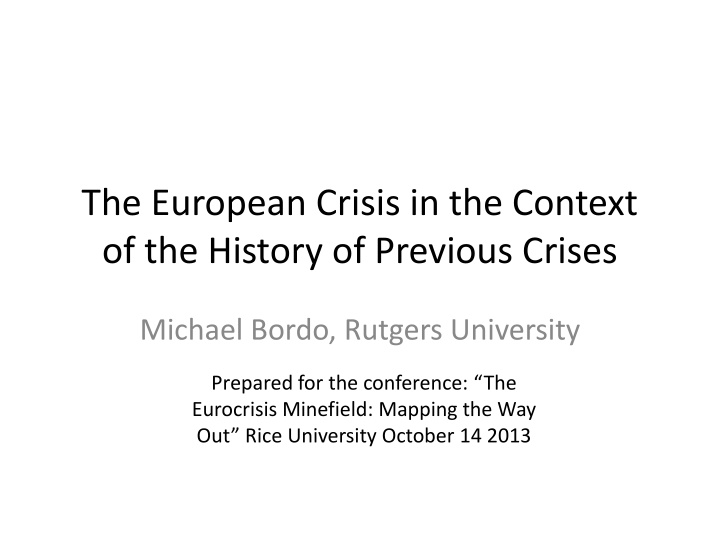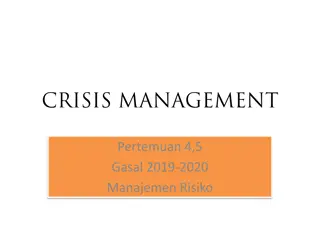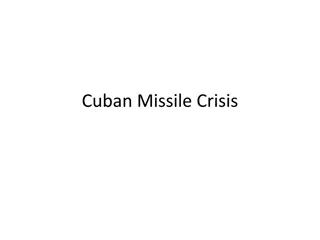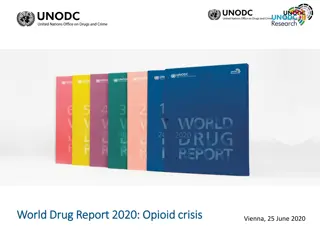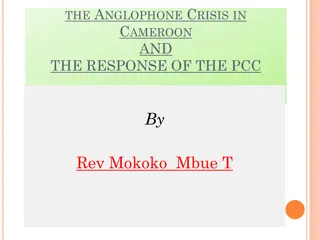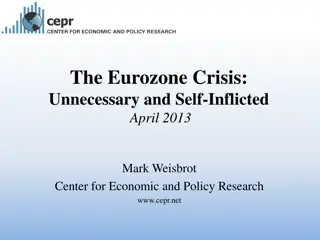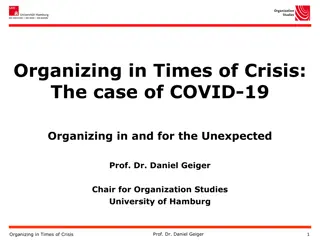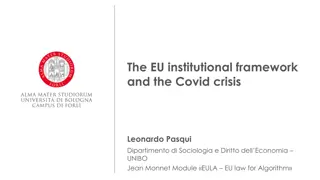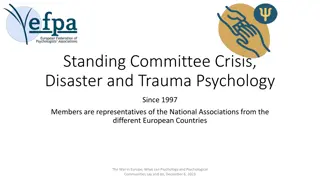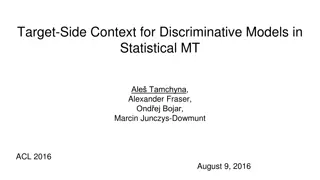Analyzing European Crisis in Historical Context
This paper delves into the Eurozone crisis through the lens of historical financial crises, examining parallels with the gold standard, financial sector linkages, and the political economy of exchange rate regimes. It explores the impact of fiscal and monetary orthodoxies, comparing the pre-WWI gold standard era with today's economic landscape. Figure 1 illustrates public debt as a share of GDP during the gold standard period, highlighting key economic trends. The benefits and risks associated with the gold standard are discussed, shedding light on its impact on bond yields and vulnerabilities to sudden stops in capital flows.
Download Presentation

Please find below an Image/Link to download the presentation.
The content on the website is provided AS IS for your information and personal use only. It may not be sold, licensed, or shared on other websites without obtaining consent from the author.If you encounter any issues during the download, it is possible that the publisher has removed the file from their server.
You are allowed to download the files provided on this website for personal or commercial use, subject to the condition that they are used lawfully. All files are the property of their respective owners.
The content on the website is provided AS IS for your information and personal use only. It may not be sold, licensed, or shared on other websites without obtaining consent from the author.
E N D
Presentation Transcript
The European Crisis in the Context of the History of Previous Crises Michael Bordo, Rutgers University Prepared for the conference: The Eurocrisis Minefield: Mapping the Way Out Rice University October 14 2013
Introduction This paper analyzes the Eurozone crisis in the context of historical financial crises It integrates three stories: the classical gold standard; financial sector linkages; the domestic and international political economy of exchange rate regimes 2
The Gold Standard The parallel between the classical gold standard and EMU has often been made In both positive and negative ways Adherence to the gold standard and to EMU involved acceptance of : Monetary orthodoxy gold convertibility then, price stability now Fiscal orthodoxy in both regimes the avoidance of fiscal deficits was to protect the monetary objective 3
The Gold Standard Pre WWI peacetime G/Y was low as was D/Y, today much higher See figure 1 EMU has much higher G/Y and D/Y 4
Figure 1. Public Debt as a Share of GDP in Gold Standard (IMF Historical Debt Database) 120.0 100.0 80.0 Argentina 60.0 Germany Russia UK 40.0 20.0 0.0 1886 1887 1888 1889 1890 1895 1896 1897 1898 1903 1904 1905 1906 1907 1912 1913 1885 1891 1892 1893 1894 1899 1900 1901 1902 1908 1909 1910 1911 5
The Gold Standard The benefits of the gold standard: ease of a common monetary standard access to capital markets (to overcome original sin) reduction of borrowing costs as a contingent rule (suspension in the event of wartime and other emergencies) which acted as a safety valve 6
The Gold Standard The gold standard led to a convergence of bond yields See figure 2 But the gold standard had significant risks 1. Sudden stops (capital flow reversals could hammer emerging countries with extensive foreign loans) Eg Argentina in 1890 7
Figure 2. London Bond Spreads, Core and Periphery, 1870-1940 External Bond Spread: 14 Core & Empire Bonds External Bond Spread: 13 Periphery Bonds 8
The Gold Standard 2. Capital inflows led to an expansion of the banking system which was exposed to sudden stops often leading to financial crises See figure 3 Eg Italy and Australia 1893, USA 1873 3. A strong and effective state could underpin a banking system leading to greater exposure to capital inflows Eg Russia 9
Figure 3. Capital Mobility and the Incidence of Banking Crisis: All Countries, 1800-2008 10
The Gold Standard 3. International diplomatic commitment enhanced domestic borrowing power and hence vulnerability eg Russia connection with France in the 1890s 4. Popular political discontent eventually limited the possibility of adjustment Eg Russia 11
Four Trilemmas The linkages of these issues are summarized in four trilemmas 1. The Macroeconomic classic: fixed exchange rates, capital flows, independent monetary policy 2. The financial sector: fixed exchange rates, capital flows, financial stability 3. The international relations setting; fixed exchange rates, capital flows, national policy independence 4. The political economy: fixed exchange rates, capital flows, democratization 12
The Interwar All four trilemmas became impossible in the interwar 1. The asymmetry of the adjustment problem in the GE standard of the 1920s The surplus countries eg France and USA sterilized gold inflows and put deflationary pressure on the deficit countries eg UK 2. High inflation destroyed the capital base of banks in the WWI losers making them vulnerable to sudden stops 13
The Interwar 3. Debtors who took on international commitments eg Germany enhanced their credibility which increased their exposure to sudden stops 4. Taking on international commitments became a focus of domestic political discontent when the Great Contraction required adjustment by deflation 14
The EMU Story The move in Europe to MU for weaker countries was a credibility enhancing mechanism that would lower borrowing costs For countries that were strong creditors MU was seen as depoliticizing the adjustment process MU was seen as a way to avoid currency crises when imbalances built up EMU was established without a fiscal union which would be unnecessary because of the no bailout clause 15
The EMU Story After entry into EMU bond spreads fell to almost zero as the ECB was bound to treat all government bonds as equal See figure 4 EMU worked quite well as a disciplining mechanism before it went into effect but much less well afterwards See figure 5 16
Figure 5. General Government Net Borrowing/Lending, 1990s and 2000s (% of GDP) 1991-2000 2000-2011 18
The EMU Story A major blow to EMU came when France and Germany ignored the SGP in 2003 This had a corrosive effect on other countries. Fiscal discipline deteriorated in the 2000s Debt holding became internationalized across EMU countries 19
The Trilemmas in EMU The trilemmas became an increasing constraint in the years after EMU 1. Banking expanded after EMU leading to an explosion of bank credit See figure 6 2. Bank expansion could go on longer because of an implicit government backstop 20
The Trilemmas in EMU It was reversed when government debt management no longer looked credible, in the Greek case after the elections of 2009 Fears about the Greek financial system produced an intermediation through foreign banks See figures 7, 8 and 9 22
Figure 7. Greek Bank claims (assets/loans) on foreign/domestic MFIs 140,000 120,000 other countries 100,000 UK Millions of Euros Bulgaria, Romania, Poland 80,000 Cyprus 60,000 Luxembourg 40,000 Core: Germany, Austria, Belgium, Netherlands France 20,000 PIIS 0 Dec-10 Dec-05 Oct-06 Oct-11 Aug-02 Aug-07 Apr-09 Apr-04 Nov-03 Nov-08 Jan-03 Jan-08 Sep-04 Feb-10 Feb-05 Sep-09 May-06 May-11 Jun-03 Jun-08 Jul-05 Jul-10 Mar-07 Mar-02 Domestic 23
Figure 8. Net Change in Greek Bank Liabilities to Other Banks, March 2008 - March 2010 20,000.00 Cyprus Luxembourg Bulgaria, Romania, Poland 15,852.13 France 15,000.00 Core: Germany, Austria, Belgium, Netherlands Other PIIS Domestic 10,000.00 Britain Millions of Euros 4,943.77 4,328.35 5,000.00 1,183.00 1,117.55 978.59 356.33 0.00 (2171.72) (5,000.00) (7588.03) 24 (10,000.00)
Figure 9. Net Change in Greek Bank Assets of Other Banks: March 2008 - March 2010 40,000.00 36,396.91 Cyprus 35,000.00 Luxembourg Bulgaria, Romania, Poland 30,000.00 France Core: Germany, Austria, Belgium, Netherlands 25,000.00 other countries Millions of Euros PIIS 20,000.00 Domestic 13,402.40 Britain 15,000.00 10,000.00 4,869.72 5,000.00 740.01 0.00 (395.09) (426.78) (465.12) (482.05) (597.00) (5,000.00) March 2008 - March 2010 25
The Trilemmas in EMU 3. The implicit national government backstop was only credible because of the international commitment to the EMU project That led markets to believe that there were no limits to the accumulation of debt When the Germans and French at Deauville demanded a haircut for Greek creditors bond yields diverged See figure 10 26
Figure 10. Public Debt as Share of GDP in some EMU countries 180.0 160.0 140.0 120.0 France Germany 100.0 Greece 80.0 Ireland Italy 60.0 Spain 40.0 20.0 0.0 1986 1987 1991 1992 1996 1997 2001 2002 2003 2006 2007 2008 2011 1983 1984 1985 1988 1989 1990 1993 1994 1995 1998 1999 2000 2004 2005 2009 2010 27
The Trilemmas in EMU 4. Cross border capital flows through the banking system especially in small countries became potentially dangerous as the banks became too large for national governments to rescue them 5. When the popular backlash occurred it took the form of rejection of the cross border commitment mechanism eg Greece and Italy The trilemmas were worse because of an absence of an escape clause as in the gold standard This meant greater debt reduction which raised the question of the distribution of the losses between the private and public sector 28
The Trilemmas in EMU The result is reminiscent of the interwar political debate about whether American private creditors or European official reparations creditors should have priority in the payment of German debts What made the interwar slump so intractable was that it was not just a financial issue, but also a crisis of democracy, of social stability , and of the international political system In the interwar, increased social tension because of high unemployment made normal democratic politics impossible Domestic political pressure also became a source of heightened international tension 29
The Trilemmas in EMU This is true in Europe today Democracy has become a central target of complaints by the European elite The 2013 Cyprus crisis exposed two new dimensions to the clash over Europe s debt and banking crisis The discussion of a levy on bank deposits and whether small customers should be exempted puts class conflict at center stage 30
Conclusion Supranational commitments do not change the problems imposed by the adjustment requirement The asymmetric character of crisis adjustment is more apparent in the modern era (and in the interwar) than under the classical gold standard A design that excluded a contingent clause made the EMU system at first apparently more robust, but aggravated the eventual adjustment issue 31
Conclusion That is why the initial crisis may not have been so acute as in some of the gold standard sudden stops eg Argentina 1890 But the recovery is painfully slow See figure 11 The instability is increased by the heightened complexity and length of credit chains, and by the fact of the mediation of credits through small country banking centers 32
Figure 11. Real GDP after Financial Crisis 140 130 120 110 France Germany 100 Greece 90 Ireland 80 Italy Spain 70 Argentina 1889 60 50 40 0 1 2 3 4 5 6 33
